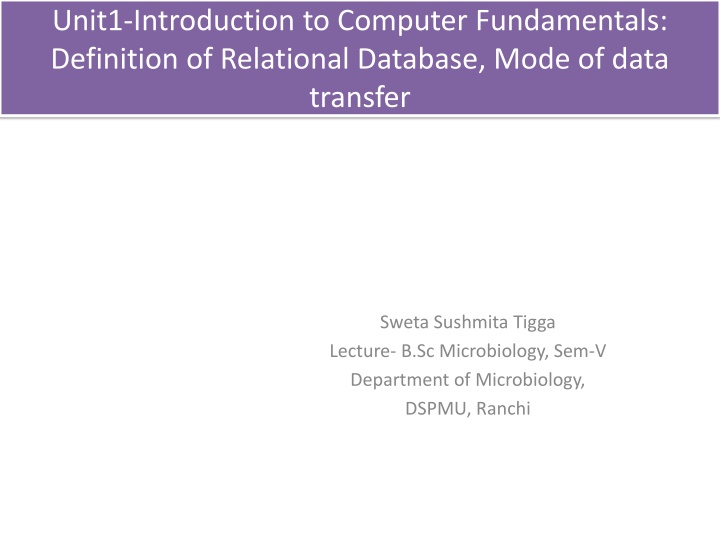
Relational Databases and RDBMS: Basics and Management
Explore the definition of relational databases, the mode of data transfer, and the role of RDBMS in managing structured information. Learn how relational databases store data points related to one another in tables, making it efficient to establish relationships among data points.
Download Presentation

Please find below an Image/Link to download the presentation.
The content on the website is provided AS IS for your information and personal use only. It may not be sold, licensed, or shared on other websites without obtaining consent from the author. If you encounter any issues during the download, it is possible that the publisher has removed the file from their server.
You are allowed to download the files provided on this website for personal or commercial use, subject to the condition that they are used lawfully. All files are the property of their respective owners.
The content on the website is provided AS IS for your information and personal use only. It may not be sold, licensed, or shared on other websites without obtaining consent from the author.
E N D
Presentation Transcript
Unit1-Introduction to Computer Fundamentals: Definition of Relational Database, Mode of data transfer Sweta Sushmita Tigga Lecture- B.Sc Microbiology, Sem-V Department of Microbiology, DSPMU, Ranchi
Unit1-Introduction to Computer Fundamentals: Definition of Relational Database, Mode of data transfer Database Relational Database Relational Database Management System (RDBMS) Programming Language
Database Structured information Or data- Database is an organized collection of Typically stored in electronically in a computer system Controlled Database Mangement System (DBMS)
Relational Database Relational Database is a type of database, that stores and provide access to data points that are related to one another. Relational databases are based on the relational model, an intuitive, representing data in tables. In a relational database, each row in the table is a record with a unique ID called the key. The columns of the table hold attributes of the data, and each record usually has a value for each attribute, making it easy to establish the relationships among data points straightforward way of
Relational Database Relational Databases are structured- the data table, views, indexes. This separation means that database administrators can manage physical data storage without affecting access to that data as a logical structure. For example, renaming a database file does not rename the tables stored within it.
Relational Database Mangement System (RDBMS) A relational database management system (RDBMS) is a program that allows you to. Most relational database management systems use the SQL language to access the database and administer a relational database. update Create
SQL (Structured Query Language) SQL (Structured Query Language) is a programming language used to communicate with data stored in a relational database management system. SQL syntax is similar to the English language, which makes it relatively easy to write, read, and interpret. Many RDBMS use SQL (and variations of SQL) to access the data in tables. For example, SQLite is a relational database management system. SQLite contains a minimal set of SQL commands (which are the same across all RDBMSs). Other RDBMS may use other variants.
Popular Relational Database Management System 1. MySQL 2. PostgreSQL 3. SQLite
SQLite SQLite is a popular open source SQL database. It can store an entire database in a single file. One of the most significant advantages this provides is that all of the data can be stored locally without having database to a server. SQLite is a popular choice for databases in cellphones, PDAs, MP3 players, set-top boxes, and other electronic gadgets. to connect your
MySQL MySQL is the most popular open source SQL database. It is typically used for web application development, and often accessed using PHP. The main advantages of MySQL are that it is easy to use, inexpensive, reliable (has been around since 1995), and has a large community of developers who can help answer questions. Some of the disadvantages are that it has been known to suffer from poor performance when scaling, open source development has lagged since Oracle has taken control of MySQL, and it does not include some advanced features that developers may be used to.
PostgreSQL PostgreSQL is an open source SQL database that is not controlled by any corporation. It is typically used for web application development. PostgreSQL shares many of the same advantages of MySQL. It is easy to use, inexpensive, reliable and has a large community of developers. It also provides some additional features such as foreign key support without requiring complex configuration. The main disadvantage of PostgreSQL is that it is slower in performance than other databases such as MySQL. It is also less popular than MySQL which makes it harder to come by hosts or service providers that offer managed PostgreSQL instances.
